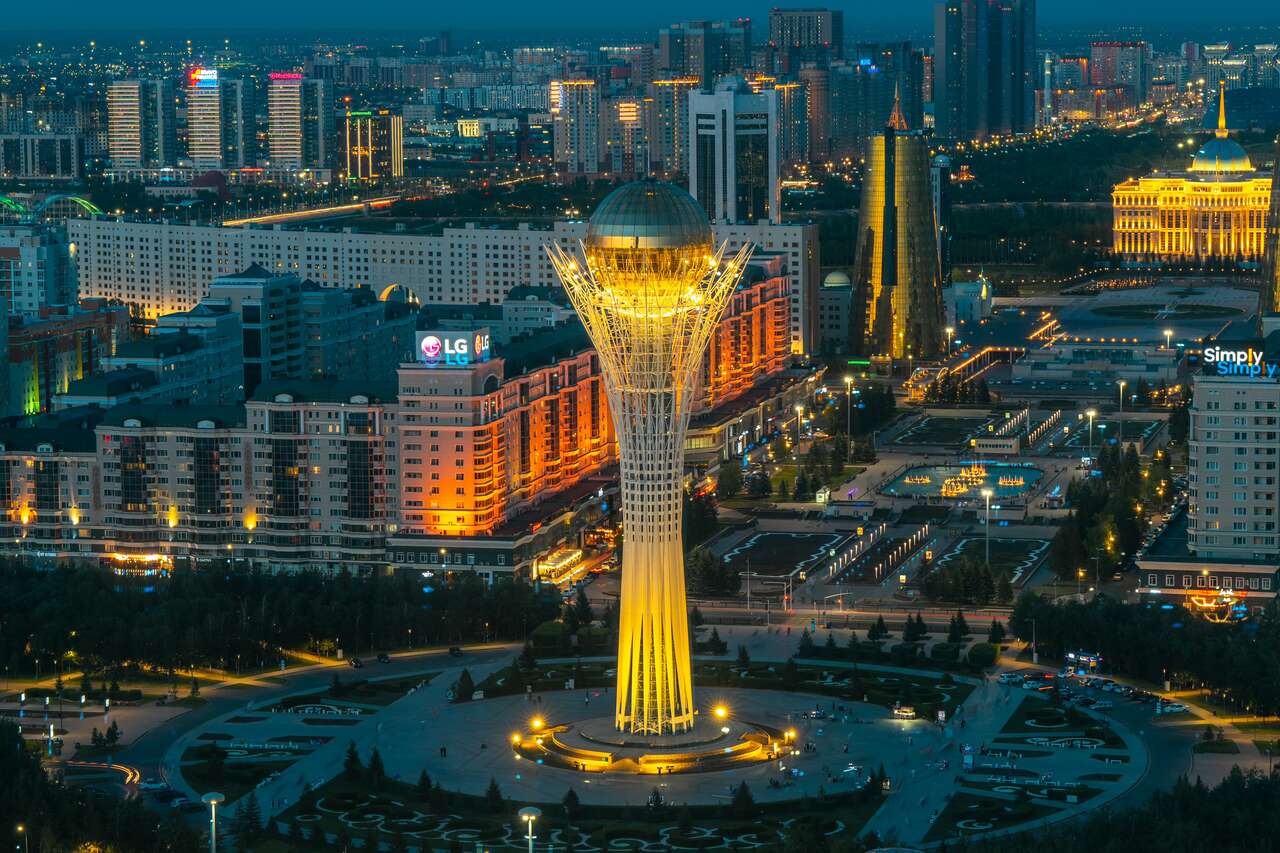Astana 020000. This postal code pinpoints the heart of Astana, Kazakhstan, a city resurrected from the vast Kazakh steppe. Once a quiet outpost, it now stands as a testament to Kazakhstan’s ambitious vision for the future, a dynamic blend of futuristic architecture and the echoes of its Silk Road past.
Exploring Astana’s Dynamic Identity
From a humble settlement along the Ishim River, Astana 020000 has undergone a remarkable metamorphosis. More than a mere facelift, it represents a nation’s dreams etched onto the landscape. But what does this rapid transformation mean for the soul of Kazakhstan?
A City Forged in History
Astana 020000 resides in a city with a unique distinction: the Guinness World Record for most name changes of a capital. Akmoly, Akmolinsk, Tselinograd, Akmola, Astana, Nur-Sultan, and back to Astana—each name whispers a story of evolving aspirations and a nation finding its place on the world stage.
Decoding 020000: The City’s Pulse
Astana 020000 is more than a postal code; it’s the city’s central nervous system. Here, gleaming skyscrapers rise beside remnants of the Soviet era, creating a dialogue between past and present. Does this juxtaposition suggest harmony or a stark reminder of relentless change?
Architectural Wonders of the Steppe
Astana 020000 showcases architectural audacity. The Bayterek Tower, a futuristic “tree of life,” dominates the skyline, while the Khan Shatyr Entertainment Center offers a climate-controlled refuge, a testament to human ingenuity. But how do these grand symbols of progress impact local businesses? Are they thriving alongside these giants, or struggling to keep pace?
The Human Story of Astana
Beyond the steel and glass lie the human stories of Astana 020000. From market vendors to government officials, their lives form a rich tapestry. How has the city’s rapid growth reshaped their lives, hopes, and challenges? These questions add depth to the narrative of Astana 020000.
A City in Perpetual Motion
Astana 020000 is a work in progress, constantly evolving. The city faces the delicate balancing act of embracing progress while preserving its unique character. Can it become a global city without sacrificing its Kazakh identity? Time will tell what the future holds for this dynamic city at the center of it all.
Is Astana Part of Russia?
Astana’s prominence in global news and its distinctive architecture sometimes prompts the question: Is it part of Russia? Given the historical connections between Kazakhstan and Russia, this is understandable. However, the answer is definitively no. Astana is the capital of Kazakhstan, a sovereign nation with its own unique culture, government, and aspirations.
Kazakhstan, with Astana as its vibrant heart, stands as an independent nation. Though its history is interwoven with Russia’s, especially during the Soviet era, Kazakhstan declared independence in 1991. Astana’s designation as the capital in 1997 solidified this separation, symbolizing national identity and self-determination. See our detailed articles on area code 00221 and area code 00966 for insights into how communication networks reflect global connections.
The city’s name reflects Kazakhstan’s journey. From Akmoly to Akmolinsk, Tselinograd (during Soviet rule), back to Akmola, then Astana, briefly Nur-Sultan, and finally returning to Astana in 2022—these shifts likely reflect the nation’s evolving relationship with its past and its vision for the future.
The relationship between Kazakhstan and Russia is complex. A shared border and Soviet history have undoubtedly shaped cultural exchanges and economic ties. However, Kazakhstan’s independence marks a clear divergence, forging its own political, economic, and cultural path. Some experts suggest ongoing collaborations and dialogues, while others point to Kazakhstan’s diversification of international partnerships.
Relocating the capital from Almaty to Astana in 1997 was highly symbolic, a fresh start for the nation. It could also be interpreted as a strategic move towards national unity, placing the capital in a more central location. Ongoing research explores how Astana’s urban design reflects and shapes Kazakhstan’s identity.
Astana’s modern architecture might be seen as a physical manifestation of Kazakhstan’s aspirations, a testament to progress on its own terms. Similarities with Russian cities likely stem from the shared Soviet past, but Astana possesses a distinct character, shaped by Kazakhstan’s unique cultural blend.
Our understanding of geopolitics is ever-evolving. Further research may offer additional insights into the Kazakhstan-Russia relationship and how Astana embodies the nation’s independent identity. Astana’s location in north-central Kazakhstan, along the Ishim River, further solidifies its position within Kazakhstan. Its population, over 1 million, adds to its significance as a major urban center.
Is Astana in Europe or Asia?
Astana (briefly Nur-Sultan) sparks the question: Is it in Europe or Asia? The answer isn’t simple. Geographically, Astana leans towards Asia, situated east of the Ural Mountains and Ural River, the traditional continental divide. More specifically, it’s nestled in Central Asia, a region with its own distinct identity.
Central Asia is a vibrant mosaic of cultures, with countries like Kazakhstan, Kyrgyzstan, Tajikistan, Turkmenistan, and Uzbekistan each contributing unique elements. Astana, as Kazakhstan’s capital, sits at the heart of this dynamic region.
However, Astana isn’t just geographically Asian; it’s a fascinating blend of East and West. Russian conversations, glimpses of Islamic architecture, and the unique flavors of Kazakh cuisine all contribute to a distinctive Eurasian flavor. This fusion stems from centuries of trade, migration, and cultural exchange.
Astana’s story as the capital began in 1997, marking a bold move towards modernization. This transition propelled Astana onto the world stage, transforming it into a dynamic metropolis.
Amidst its modern transformation, Astana retains a connection to its cultural heritage. It’s a city that respects its past while embracing the future, balancing progress with tradition. Astana’s location at the crossroads of Eurasia adds geopolitical weight. It has become a pivotal player in international affairs, hosting diplomatic meetings and fostering dialogue between East and West.
While geographically in Asia, Astana is a place where different worlds converge. It challenges traditional notions of “East” and “West” and deserves exploration. While experts may agree on its geographic location, its cultural identity remains fluid, reflecting the region’s complex history and evolution. Ongoing research continually reveals new perspectives.
What is Astana Kazakhstan Known For?
Astana, back to its original name after briefly being Nur-Sultan, embodies Kazakhstan’s blend of tradition and innovation, set against a backdrop of striking architecture. It’s a city built on ambition, rising from the vast Kazakh steppe.
From a small outpost in 1830 (Akmoly) to becoming the capital, Astana’s journey is remarkable. Its name changes reflect a nation forging its identity. The 1997 move of the capital from Almaty to Astana was a statement: a forward-looking Kazakhstan ready for the world stage. Its central location along the Ishim River was a strategic choice for national unity. See our articles on area code 00221 and area code 00966 to learn how communication connects different parts of the world.
Astana’s architecture is striking. Shimmering skyscrapers define the skyline. The Bayterek Tower, an iconic symbol of the mythical tree of life, offers breathtaking panoramic views. The Palace of Peace and Reconciliation, a stunning glass and steel pyramid, hosts important dialogues. These architectural marvels, designed by giants like Norman Foster, symbolize the city’s ambition. The Nur-Astana Mosque, a beacon of faith, and the Khan Shatyr Entertainment Center, a gigantic tent-like structure, add to the unique cityscape.
Beyond the buildings, Astana is a cultural melting pot. Museums like the National Museum of the Republic of Kazakhstan showcase the country’s rich history. Theaters resonate with traditional Kazakh music and international performances. Art galleries showcase a vibrant blend of traditional and modern influences. The multilingual streets, alive with Kazakh, Russian, and English, reflect Astana’s cosmopolitan character.
Astana is also an economic powerhouse, a key business and financial hub in Central Asia. It attracts global investment, fueling growth in industries from construction and transportation to communications.
Wide boulevards lined with green parks demonstrate Astana’s commitment to sustainable growth. A modern public transport system connects its neighborhoods. World-class restaurants offer diverse culinary experiences, and the nightlife is surprisingly dynamic.
From nomadic heritage to futuristic aspirations, Astana is a city of contrasts where tradition meets innovation. It constantly pushes boundaries, answering the question “What’s next?” with towering skyscrapers, vibrant cultural experiences, and a palpable sense of progress.
- Georgia Platform: A Southern Strategy, 1850s - March 31, 2025
- How many weeks is 40 days: Quick Conversion Guide for Accurate Results - March 31, 2025
- How many feet is 300 meters? 984 Feet: Understand Length Conversions Easily - March 31, 2025

















1 thought on “Astana 020000: Unveiling the Heart of Modern Kazakhstan”
Comments are closed.